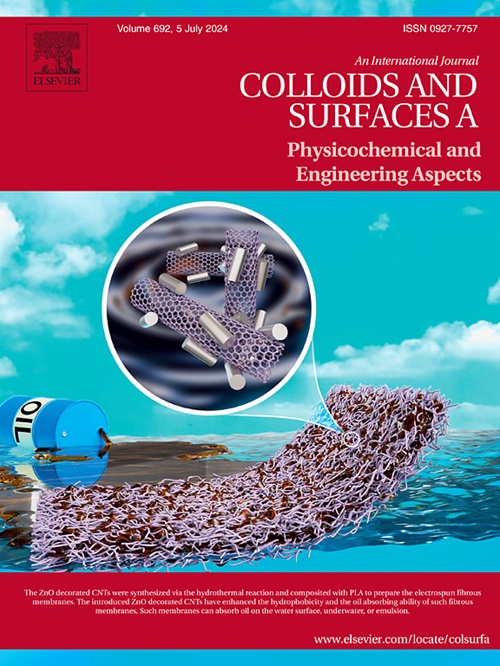Unleashing the synergistic potential of zeolite-hydroxyapatite for Th(IV) and U(VI) sequestration: Reusability and industrial effluent applications
IF 4.9
2区 化学
Q2 CHEMISTRY, PHYSICAL
Colloids and Surfaces A: Physicochemical and Engineering Aspects
Pub Date : 2025-04-27
DOI:10.1016/j.colsurfa.2025.137052
引用次数: 0
Abstract
Contamination of water bodies with radioactive heavy metals such as thorium (Th(IV)) and uranium (U(VI)) poses significant risks to human health and the environment. Developing sustainable and efficient technologies for their removal is therefore critical for environmental protection and resource recovery. In this study, a fly ash-derived zeolite-hydroxyapatite (HApZ) composite was synthesized via a one-step hydrothermal method at three different temperatures: 50 °C (HApZ(50)), 100 °C (HApZ(100)), and 150 °C (HApZ(150)). The hydrothermal temperature significantly influenced the crystallinity, morphology, and surface area of the composites. Among them, HApZ(100) exhibited the highest surface area (351 m² g⁻¹) and outstanding adsorption capacities of 793 mg g⁻¹ for Th(IV) and 872 mg g⁻¹ for U(VI), owing to the synergistic integration of zeolite and hydroxyapatite phases. The adsorption behavior followed the Langmuir isotherm and pseudo-second-order kinetics, indicating monolayer adsorption and chemisorption as the dominant mechanisms. HApZ(100) demonstrated excellent reusability, retaining 81 % for Th(IV) and 89 % for U(VI) removal efficiency after six regeneration cycles and maintained robust performance even up to ten cycles. Economic assessment confirmed the cost-effectiveness of the HApZ(100) (∼33.41 USD per kg) which is substantially lower in price than the activated carbon, ion exchange resin, and other adsorbents. Moreover, HApZ(100) achieved complete removal of Th(IV) and U(VI) from the industrial effluent, even in complex multi-ion systems. These findings underscore the effectiveness of HApZ(100) as a sustainable and promising material for wastewater treatment, environmental remediation, and resource recovery.
释放沸石-羟基磷灰石对Th(IV)和U(VI)隔离的协同潜力:可再利用性和工业废水应用
水体受到放射性重金属污染,如钍(Th(IV))和铀(U(VI)),对人类健康和环境构成重大风险。因此,开发可持续和有效的清除技术对环境保护和资源回收至关重要。本研究采用一步水热法在50℃(HApZ(50))、100℃(HApZ(100))和150℃(HApZ(150))三种不同温度下合成了粉煤灰衍生的沸石-羟基磷灰石(HApZ)复合材料。水热温度对复合材料的结晶度、形貌和表面积有显著影响。其中,由于沸石和羟基磷灰石相的协同整合,HApZ(100)表现出最大的表面积(351 m²g⁻¹)和对Th(IV)的793 mg g⁻¹ 和对U(VI)的872 mg g⁻¹ 的卓越吸附能力。吸附行为遵循Langmuir等温线和拟二级动力学,表明单层吸附和化学吸附是主要吸附机理。haz(100)表现出良好的可重复使用性,经过6次再生循环后,对Th(IV)和U(VI)的去除率分别保持了81 %和89 %,甚至在10次循环后仍保持了良好的性能。经济评估证实了HApZ(100)的成本效益(每公斤33.41美元),其价格大大低于活性炭、离子交换树脂和其他吸附剂。此外,即使在复杂的多离子系统中,HApZ(100)也能从工业废水中完全去除Th(IV)和U(VI)。这些发现强调了HApZ(100)作为废水处理、环境修复和资源回收的可持续和有前途的材料的有效性。
本文章由计算机程序翻译,如有差异,请以英文原文为准。
求助全文
约1分钟内获得全文
求助全文
来源期刊
CiteScore
8.70
自引率
9.60%
发文量
2421
审稿时长
56 days
期刊介绍:
Colloids and Surfaces A: Physicochemical and Engineering Aspects is an international journal devoted to the science underlying applications of colloids and interfacial phenomena.
The journal aims at publishing high quality research papers featuring new materials or new insights into the role of colloid and interface science in (for example) food, energy, minerals processing, pharmaceuticals or the environment.

 求助内容:
求助内容: 应助结果提醒方式:
应助结果提醒方式:


